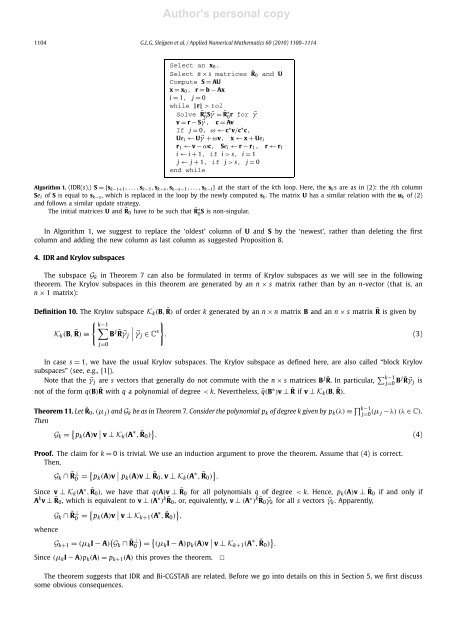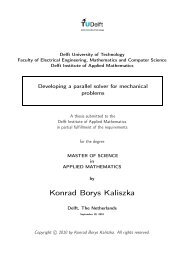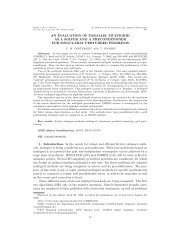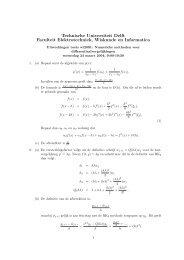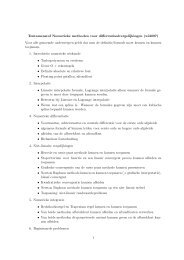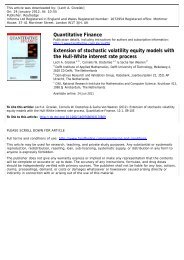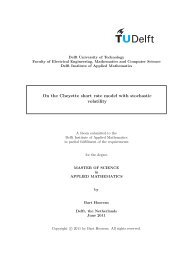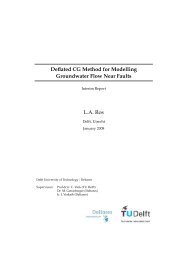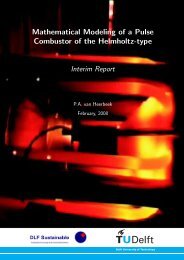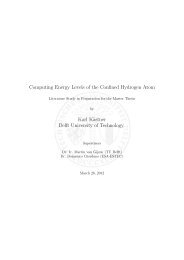Gerard L.G. Sleijpen, Peter Sonneveld and Martin B. van Gijzen, Bi ...
Gerard L.G. Sleijpen, Peter Sonneveld and Martin B. van Gijzen, Bi ...
Gerard L.G. Sleijpen, Peter Sonneveld and Martin B. van Gijzen, Bi ...
Create successful ePaper yourself
Turn your PDF publications into a flip-book with our unique Google optimized e-Paper software.
Author's personal copy<br />
1104 G.L.G. <strong>Sleijpen</strong> et al. / Applied Numerical Mathematics 60 (2010) 1100–1114<br />
Select an x 0 .<br />
Select n × s matrices ˜R0 <strong>and</strong> U<br />
Compute S = AU<br />
x = x 0 , r = b − Ax<br />
i = 1, j = 0<br />
while ‖r‖ > tol<br />
Solve ˜R∗<br />
0 S ⃗γ = ˜R∗<br />
0r for ⃗γ<br />
v = r − S ⃗γ , c = Av<br />
If j = 0, ω ← c ∗ v/c ∗ c,<br />
Ue i ← U ⃗γ + ωv, x ← x + Ue i<br />
r 1 ← v − ωc, Se i ← r − r 1 , r ← r 1<br />
i ← i + 1, if i > s, i = 1<br />
j ← j + 1, if j > s, j = 0<br />
end while<br />
Algorithm 1. (IDR(s).) S =[s k−i+1 ,...,s k−1 , s k−s , s k−s−1 ,...,s k−i ] at the start of the kth loop. Here, the s k sareasin(2):theith column<br />
Se i of S is equal to s k−s , which is replaced in the loop by the newly computed s k .ThematrixU has a similar relation with the u k of (2)<br />
<strong>and</strong> follows a similar update strategy.<br />
The initial matrices U <strong>and</strong> ˜R0 have to be such that ˜R∗<br />
0S is non-singular.<br />
In Algorithm 1, we suggest to replace the ‘oldest’ column of U <strong>and</strong> S by the ‘newest’, rather than deleting the first<br />
column <strong>and</strong> adding the new column as last column as suggested Proposition 8.<br />
4. IDR <strong>and</strong> Krylov subspaces<br />
The subspace G k in Theorem 7 can also be formulated in terms of Krylov subspaces as we will see in the following<br />
theorem. The Krylov subspaces in this theorem are generated by an n × s matrix rather than by an n-vector (that is, an<br />
n × 1matrix):<br />
Definition 10. The Krylov subspace K k (B, ˜R) of order k generated by an n × n matrix B <strong>and</strong> an n × s matrix ˜R is given by<br />
{ ∑k−1<br />
∣<br />
K k (B, ˜R) ≡ B j ˜R ⃗γ ∣∣<br />
j ⃗γ j ∈ C<br />
}. s (3)<br />
j=0<br />
In case s = 1, we have the usual Krylov subspaces. The Krylov subspace as defined here, are also called “block Krylov<br />
subspaces” (see, e.g., [1]).<br />
Note that the ⃗γ j are s vectors that generally do not commute with the n × s matrices B j ˜R. Inparticular,<br />
∑ k−1<br />
j=0 B j ˜R ⃗γ j is<br />
not of the form q(B) ˜R with q a polynomial of degree < k. Nevertheless, ¯q(B ∗ )v ⊥ ˜R if v ⊥ Kk (B, ˜R).<br />
Theorem 11. Let ˜R0 , (μ j ) <strong>and</strong> G k be as in Theorem 7. Consider the polynomial p k of degree k given by p k (λ) ≡ ∏ k−1<br />
j=0 (μ j −λ) (λ ∈ C).<br />
Then<br />
G k = { p k (A)v ∣ ∣ v ⊥ Kk (A ∗ , ˜R0 ) } . (4)<br />
Proof. The claim for k = 0 is trivial. We use an induction argument to prove the theorem. Assume that (4) is correct.<br />
Then,<br />
G k ∩ ˜R⊥ 0 = { p k (A)v ∣ ∣ pk (A)v ⊥ ˜R0 , v ⊥ K k (A ∗ , ˜R0 ) } .<br />
Since v ⊥ K k (A ∗ , ˜R0 ), we have that q(A)v ⊥ ˜R0 for all polynomials q of degree < k. Hence, p k (A)v ⊥ ˜R0 if <strong>and</strong> only if<br />
A k v ⊥ ˜R0 , which is equivalent to v ⊥ (A ∗ ) k ˜R0 ,or,equivalently,v ⊥ (A ∗ ) k ˜R0 ⃗γ k for all s vectors ⃗γ k . Apparently,<br />
whence<br />
G k ∩ ˜R⊥ 0 = { p k (A)v ∣ ∣ v ⊥ Kk+1 (A ∗ , ˜R0 ) } ,<br />
G k+1 = (μ k I − A) ( G k ∩ ˜R⊥ 0<br />
)<br />
=<br />
{<br />
(μk I − A)p k (A)v ∣ ∣ v ⊥ Kk+1 (A ∗ , ˜R0 ) } .<br />
Since (μ k I − A)p k (A) = p k+1 (A) this proves the theorem.<br />
✷<br />
The theorem suggests that IDR <strong>and</strong> <strong>Bi</strong>-CGSTAB are related. Before we go into details on this in Section 5, we first discuss<br />
some obvious consequences.


